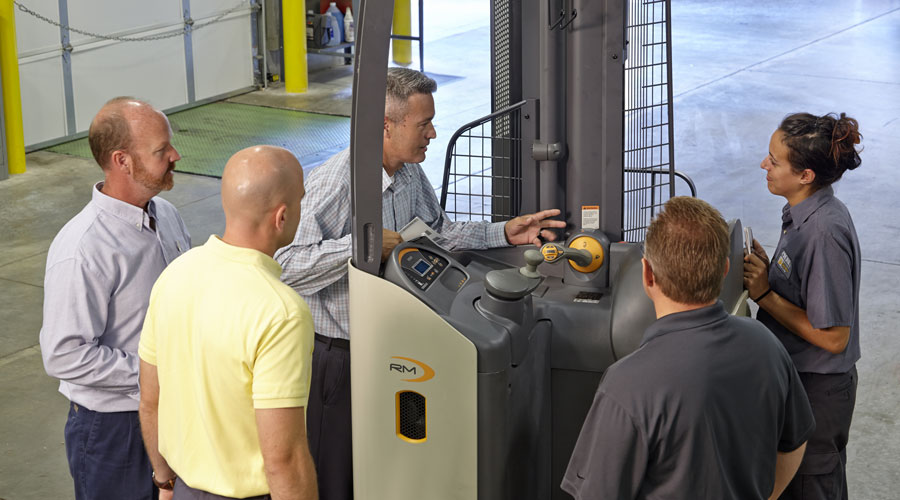Seven Questions to Identify and Address Potential Gaps in Your Training Program

Forklift safety training is an Occupational Safety and Health Administration (OSHA) requirement, but the effectiveness of forklift training programs across organizations can often vary. Gaps in a training program can compromise overall safety and diminish a company’s efforts to establish a culture focused on safety.
If you haven’t reviewed your forklift safety training program lately, these seven questions can help you comprehensively evaluate your program and address potential gaps.
1. How effective is the training we’re delivering?
Relying too much on classroom training and not providing hands-on training may limit the ability of operators to translate learning into practice immediately. In the warehouse, forklift connectivity solutions such as Crown’s InfoLink® operator and fleet management system can support training effectiveness, inform program evaluations, and help identify improvement areas.
2. What is the frequency of safety training?
An effective training program requires repetition. Otherwise, that valuable knowledge can erode over time. In the United States, OSHA mandates training every three years, but that’s a minimum requirement. Offering more frequent refresher courses can help maintain awareness to help ensure guidelines are followed.
3. Are new operators receiving safety training in a timely manner?
Turnover is a fact of life in a competitive hiring market. Does your process ensure new employees promptly receive the training necessary for a successful onboarding process? Do you have resources in place to help reinforce the training received by new hires? Training should be easily accessible, interactive, engaging and tailored to the individual. This will help give new operators the confidence to play their part in maintaining a strong safety culture.
4. Are supervisors trained to identify and correct unsafe operating practices?
Positive reinforcement by supervisors can be one of the most effective methods for sustaining safety improvements initiated by formal training programs. However, supervisors need to be trained to identify unsafe practices and deliver feedback in a way that creates long-term behavioral changes.
5. Are non-operators trained to work safely around forklifts?
Forklift operators aren’t the only ones at risk of being involved in forklift-related accidents. Distracted or inattentive pedestrians can put themselves and others in harm’s way. This can apply to your own employees as well as suppliers, visitors and customers who might enter your facility. Crown offers free training modules and videos to support this effort.
6. How is training being used to support the introduction of new technology?
New technology can introduce new safety considerations and, in many cases, enhance operator safety, but only if personnel are trained appropriately. Any effects of new technology on safe operating practices should be integrated into an operator training program.
7. Do we have the resources and expertise to effectively manage training in-house?
Effective safety training requires expertise and resources. Expertise should cover equipment operating practices, safety best practices and the mechanics of how people learn. Resources must include time for planning, executing and managing these programs, as well as the necessary budget and workforce to ensure these programs receive the attention they deserve. Even a well-designed program can get derailed if the responsible parties lack the time or expertise to make it a priority.
A supplier-based approach can help close gaps in a training program
A supplier-based approach to training can do more than simply check a box on a safety checklist. For example, Crown offers Demonstrated Performance® (DP) training programs designed to help promote forklift safety by delivering comprehensive, hands-on training that helps create meaningful behavioral changes and a strong safety culture. These training programs are available to forklift operators, trainers, supervisors, pedestrians and service technicians. A Train-the-Trainer program enables select employees to develop the expertise required to deliver in-house training when and wherever it is needed.
An essential part of maintaining a strong safety culture includes ongoing encouragement at various levels of an organization. Just as forklift operators must be trained to handle the forklift safely, supervisors should be taught to reinforce safety rules and practices and to correct unsafe operator behavior when it occurs.
With a breadth of training opportunities targeting employees at all levels of the organization, it becomes clear that encouraging safety is a shared responsibility. Crown can provide the tools to help you build and maintain your own safety culture in which each employee can embrace a role in keeping others safe.
You can learn more about Crown’s forklift training programs and how they can help develop safety practices, bolster employee performance and reduce total cost of ownership. To discover how to monitor your operations and reinforce safe behaviors, consider the benefits of Crown’s InfoLink operator and fleet management system.